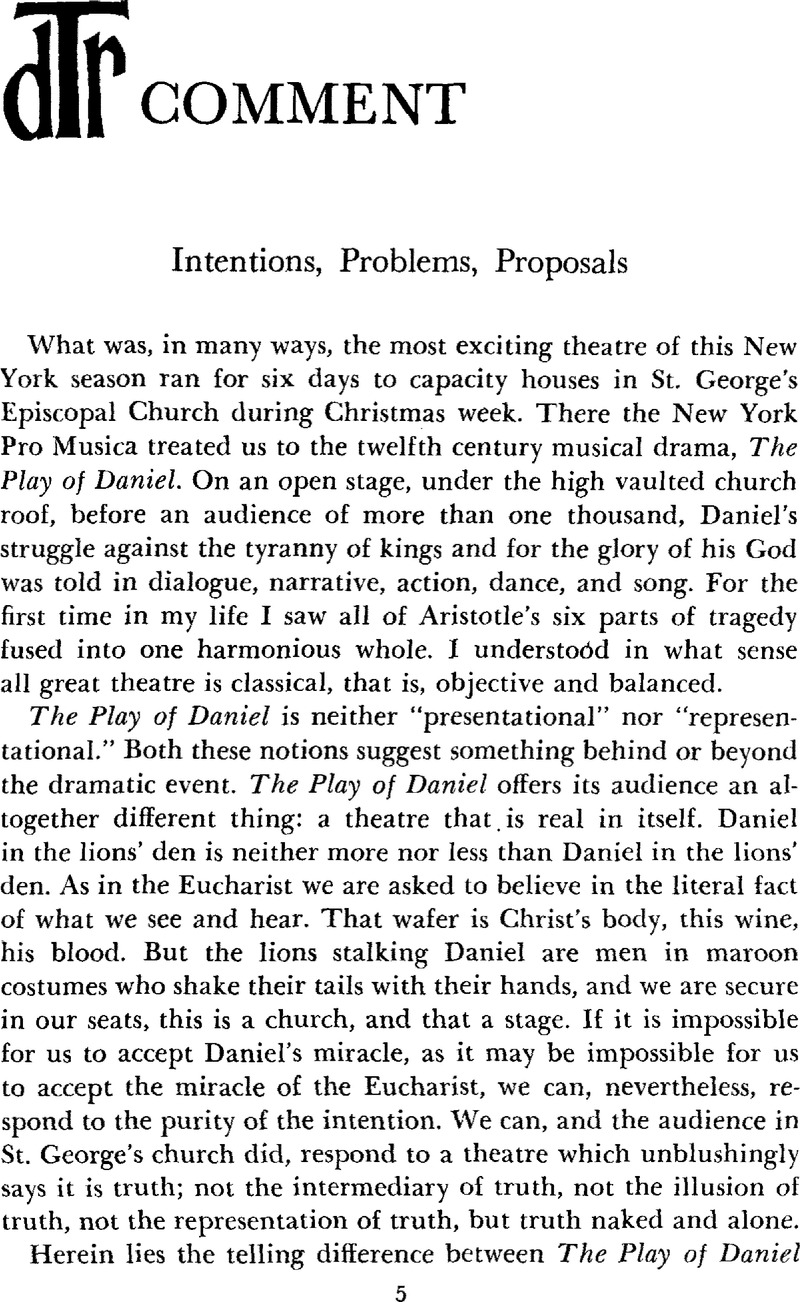Article contents
Intentions, Problems, Proposals
Published online by Cambridge University Press: 14 February 2022
Abstract

- Type
- TDR Comment
- Information
- Copyright
- Copyright © 1963 The Tulane Drama Review
References
1 Stark Young, “Painting and the Theatre,” Theatre Arts, September, 1947.
2 The New Repertory Theatre Company opened at the Masque Theatre in the spring of 1962 with a production of Schiller's Don Carlos. This was followed by Ostrovsky's The Storm. Although neither play was a hit, the two did run in repertory for a brief time. What was more important was the fact that a company had been formed and advertised on the theatre's program as such. When the theatre was reorganized during the summer (the ownership remained in the same hands) the idea of both a company and a repertory gave way to that of a cast and a run.
3 During this past winter the Living Theatre restored its repertory by re-introducing Gelber's The Connection. At the time of this writing (March, 1963) the New Repertory Theatre Company has closed its Brecht production without yet announcing its next offering.
4 It should be noted, of course, that many of “Broadway's” finest plays are imports with foreign casts and directors. This is true of The Care-taker, Beyond the Fringe, and The School for Scandal, all of which are English. Some of the most exciting theatre uptown has been given to us by the brief visits of such companies as the Royal Dramatic Theatre of Sweden and the Greek Tragedy Theatre, both of which played in New York during the 1961-1962 season.
5 All translations referred to as “Dürrenmatt's version” are by James L. Rosenberg. His excellent translations of The Visit and Romulus have not yet been published.
6 Ionesco, Eugène, “On Rhinoceros in the United States,” Notes et contre-notes (Paris: Gallimard, 1962), 185-188.Google Scholar [Author's translation.]
7 The major living examples of this kind of cooperation on our university campuses are the student newspapers, especially those dailies run without the supervision of the faculty. Here an organic operation is continuously maintained at a high quality level. As a past member of The Cornell Daily Sun I can testify to the practicability of the system. Policy was hammered out by the staff itself, with the upperclassman, of course, having most of the say. Staffers were elected to the various editorial boards after a long apprenticeship. By the time a man was in a policy position he had several years of experience behind him. The newspaper was always organically alive because the staff changed from year to year. But because this change was gradual and limited, continuity was maintained. If our campus theatre companies were established along similar lines, there is no reason to doubt that the same kind of exciting enterprise would follow.
8 That is, the dabbler can take the basic training, act in the Broadway and classical shows, enroll in classes, build sets.
9 I mean the idea of off-Broadway as it was originally conceived. As such, there is room for flourishing “off-Broadways” in a dozen of our larger cities just as there will be, undoubtedly, a commodity theatre in these cities also.
10 Perhaps the only way we will ever achieve decentralization in this country is to follow the example of Planchon in France. Planchon has his theatre in his native Lyons. Every year he goes to Paris for a brief season. He brings his best productions with him. Then he returns to Lyons for the rest of the year. To a certain degree this is the idea of APA (except that APA has no permanent home in our country yet, no deep undeniable roots in any region; it is a pick-up ensemble). How interesting it would be if the San Francisco Actors’ Workshop, the Washington Arena, and several other companies were to come to New York each year. There we could have our own intra-mural “Theatre des Nations.” Our regional theatres could earn (or lose) national respect. All this could be achieved without their losing their own distinctly regional identities. In fact, such a program would ensure their identities, since personnel would not be so quick to run off to New York if the company could assure them a brief appearance there each year. New York would then become the showcase of our national theatres, rather than the national theatre itself—a role which no single city, no matter how impressively large and sophisticated, can hope to play in a nation of nearly 200 million.
- 3
- Cited by




